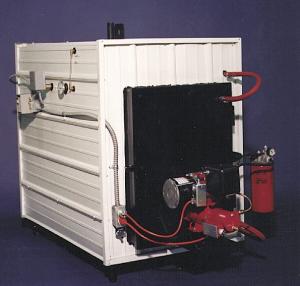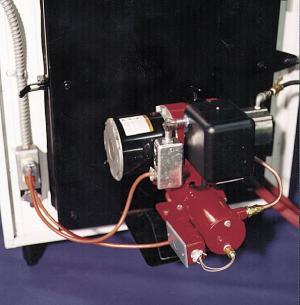Outside Waste Oil Furnace Heats Four Buildings At Once
"It's the best waste oil furnace ever built in my opinion. We've saved thousands of dollars in heating costs and and we'll go right on saving as long as we keep running this system," says Allan Dragseth of Eldred, Minn., who contacted FARM SHOW recently to tell us about his outside waste oil furnace that he's using to heat several buildings on his farm.
The first-of-its-kind furnace was designed and built by Gerry DeBoer of Crookston, Minn. Deboer has run a manufacturing shop for years that supplies components for outside wood-fired boilers that sends heated water through underground pipes to buildings that are to be heated.
Several years ago DeBoer started working on a design for an outside furnace that would burn waste oil. His first unit was fired by an Oilmatic burner which dates back to the 1940's.
"The Oilmatic uses a low-pressure nozzle with large holes that prevent plug-ups. It works great for burning waste oil because it requires almost no maintenance. The burner was actually invented during World War I and was on the market until 1951, when the company went out of business. At that time it was used for fuel oil but it was not efficient enough for more refined products. However, when you're burning waste oil you're not really concerned with efficiency. You're more concerned with how well it burns and whether it can handle dirty oil," says DeBoer.
Because the Oilmatic is no longer on the market, DeBoer has started manufacturing it himself. The burner pumps oil with a small 1/4-in. dia. piston. A vein pump injects air into the burner unit. There are no small orifices to plug up and it can be set to burn anywhere from 0 to 3 gph.
DeBoer has built and sold six of his outside waste oil burners which produce up to 650,000 btu's. His own furnace stands in a small building. Hot water is piped to 4 buildings including his house and manufacturing building. The building farthest away is 140 ft. from the furnace. A 1,000-gal. oil storage tank stands outside the furnace building. All oil is filtered before entering the building.
The furnace itself is 5 ft. long and will fit through a 36-in. door. It weighs about 800 lbs. Water from the boiler is pumped through underground pipe to heat exchangers or hot water radiators in buildings up to 300 ft. away.
"This low-pressure burner has state-of-the-art features. For example, it's fitted with a photo cell so that if there's no flame the furnace automatically shuts down. A reusable steel mesh filter prevents larger particles from reaching the furnace.
DeBoer has developed a unique way to gather oil from farmers and businesses in his area. He mounted a 400-gal. double-walled tank in his pickup. To suck oil into the tank, he simply runs a small vacuum hose to the intake manifold on the pickup engine. "People don't realize how much vacuum pressure you can create with an engine. It's unbelievable how well it works. It'll empty a 55 gal. drum filled with heavy, thick oil in 15 min. Works better than a pump," says DeBoer.
When he gets back to his place, DeBoer simply hooks up a small air compressor to push the oil out of the pickup-mounted tank into a stationary storage tank. DeBoer has enough storage for 9,000-gal. of used oil on his place so he can go out and get oil anytime during the year when he has free time. After the oil sits for a while, dirt and other particles settle out to the bottom and he siphons off the oil from the top. He burns about 3,000 gal. of used oil a year to heat his four buildings and figures he saves about $2,500 over the cost of fuel oil or propane. And because it has the same temperature controls as you would find on a conventional fuel oil furnace, is just as easy to use.
"The only thing different is that you get the fuel for free," notes DeBoer, who says he's had almost no trouble with his furnace and often goes for days without even checking it.
Allan Dragseth, the Eldred, Minn., farmer who bought one of DeBoer's furnaces last fall, uses waste oil to heat two buildings. "It works much better than other waste oil bu

Click here to download page story appeared in.
Click here to read entire issue
Outside Waste Oil Furnace Heats Four Buildings At Once ENERGY Waste Oil 23-2-19 "It's the best waste oil furnace ever built in my opinion. We've saved thousands of dollars in heating costs and and we'll go right on saving as long as we keep running this system," says Allan Dragseth of Eldred, Minn., who contacted FARM SHOW recently to tell us about his outside waste oil furnace that he's using to heat several buildings on his farm.
The first-of-its-kind furnace was designed and built by Gerry DeBoer of Crookston, Minn. Deboer has run a manufacturing shop for years that supplies components for outside wood-fired boilers that sends heated water through underground pipes to buildings that are to be heated.
Several years ago DeBoer started working on a design for an outside furnace that would burn waste oil. His first unit was fired by an Oilmatic burner which dates back to the 1940's.
"The Oilmatic uses a low-pressure nozzle with large holes that prevent plug-ups. It works great for burning waste oil because it requires almost no maintenance. The burner was actually invented during World War I and was on the market until 1951, when the company went out of business. At that time it was used for fuel oil but it was not efficient enough for more refined products. However, when you're burning waste oil you're not really concerned with efficiency. You're more concerned with how well it burns and whether it can handle dirty oil," says DeBoer.
Because the Oilmatic is no longer on the market, DeBoer has started manufacturing it himself. The burner pumps oil with a small 1/4-in. dia. piston. A vein pump injects air into the burner unit. There are no small orifices to plug up and it can be set to burn anywhere from 0 to 3 gph.
DeBoer has built and sold six of his outside waste oil burners which produce up to 650,000 btu's. His own furnace stands in a small building. Hot water is piped to 4 buildings including his house and manufacturing building. The building farthest away is 140 ft. from the furnace. A 1,000-gal. oil storage tank stands outside the furnace building. All oil is filtered before entering the building.
The furnace itself is 5 ft. long and will fit through a 36-in. door. It weighs about 800 lbs. Water from the boiler is pumped through underground pipe to heat exchangers or hot water radiators in buildings up to 300 ft. away.
"This low-pressure burner has state-of-the-art features. For example, it's fitted with a photo cell so that if there's no flame the furnace automatically shuts down. A reusable steel mesh filter prevents larger particles from reaching the furnace.
DeBoer has developed a unique way to gather oil from farmers and businesses in his area. He mounted a 400-gal. double-walled tank in his pickup. To suck oil into the tank, he simply runs a small vacuum hose to the intake manifold on the pickup engine. "People don't realize how much vacuum pressure you can create with an engine. It's unbelievable how well it works. It'll empty a 55 gal. drum filled with heavy, thick oil in 15 min. Works better than a pump," says DeBoer.
When he gets back to his place, DeBoer simply hooks up a small air compressor to push the oil out of the pickup-mounted tank into a stationary storage tank. DeBoer has enough storage for 9,000-gal. of used oil on his place so he can go out and get oil anytime during the year when he has free time. After the oil sits for a while, dirt and other particles settle out to the bottom and he siphons off the oil from the top. He burns about 3,000 gal. of used oil a year to heat his four buildings and figures he saves about $2,500 over the cost of fuel oil or propane. And because it has the same temperature controls as you would find on a conventional fuel oil furnace, is just as easy to use.
"The only thing different is that you get the fuel for free," notes DeBoer, who says he's had almost no trouble with his furnace and often goes for days without even checking it.
Allan Dragseth, the Eldred, Minn., farmer who bought one of DeBoer's furnaces last fall, uses
To read the rest of this story, download this issue below or click
here to register with your account number.








